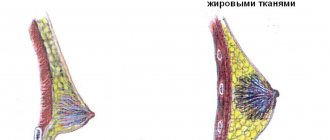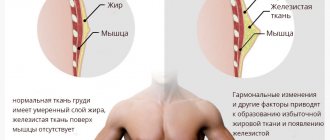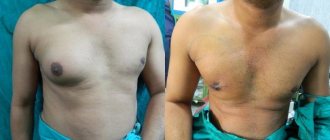Plastic surgery in men should not be obvious!
The presence in men of an excess amount of soft tissue in the chest and sub-nipple area is called gynecomastia. There are three types of gynecomastia in men:
- True gynecomastia, in which true glandular tissue is determined, dense to the touch, sometimes slightly painful, always having clear boundaries, the volume of which can decrease quite slightly with a decrease in total weight; an ultrasound examination reveals parenchymal (glandular) tissue;
- Lipomastia or false gynecomastia, when an increase in tissue in the male breast area is caused by the presence of adipose tissue, more often it is caused by excess weight, while the boundaries of the tissues in the submamillary area are practically not defined and there is no clinically significant discomfort; during an ultrasound examination, adipose tissue is determined;
- Mixed gynecomastia, in which ultrasound examination reveals the presence of parenchymal and adipose tissue, the ratio of which may be different.
The most common causes of gynecomastia include various endocrine diseases and endocrinopathies, systematic use of certain hormonal drugs, or significant weight gain. In addition, any type of gynecomastia requires a preliminary examination (ultrasound examination or puncture) to exclude breast cancer in men, although this is much rare.
Gynecomastia
Gynecomastia
– this is an enlargement (hypertrophy) of the breast in men in the form of an increase in the amount of fat and/or proliferation of glandular tissue. The breasts cease to be “flat” and become more similar in shape and size to a woman’s.
Sometimes gynecomastia can be a physiological norm: in the first months after birth (in the case of intrauterine release of a certain amount of mother’s hormones into the child’s blood), during puberty (with its characteristic hormonal surges in boys) and in old age. As a disease, gynecomastia can be false or true.
False gynecomastia
- This is an increase in the amount of adipose tissue only. This is not a dangerous manifestation, however, it brings obvious discomfort. In this case, liposuction is recommended - removal of unwanted fat accumulation.
True gynecomastia
There is also an overgrowth of glandular tissue, which requires more serious surgical intervention. This form of gynecomastia can provoke the development of life-threatening pathologies, including cancer.
Indications
The indication for surgical intervention is the patient's emotional discomfort.
Gynecomastia is a noticeable enlargement of the breasts in men. Which, according to generally accepted norms and ideals, is not an attractive feature. Rather, on the contrary: for many young people, such a feature of the figure can cause self-doubt, sometimes - ridicule and unpleasant attention from others.
True gynecomastia is a mandatory indication for surgery, not only from the point of view of aesthetic medicine. After identifying the causes of this disease and eliminating them, the patient is recommended to undergo surgery to remove the overgrown glandular tissue. This is done, as already mentioned, as a preventive measure.
Contraindications
A contraindication is the presence of certain chronic diseases: diabetes mellitus, pathologies of the cardiovascular system, autoimmune and immunosuppressive diseases. If the causes of gynecomastia are not identified or eliminated, the operation may be refused.
An absolute contraindication is childhood.
Anesthesia
As a rule, local anesthesia is used with the addition of sedation - both in the case of liposuction and in the case of combined intervention. The operation is minimally invasive and short in time.
Operation
For false gynecomastia, surgical intervention is limited to liposuction only. The operation is simple and very careful: several micropunctures are made on the skin, after which fat deposits are removed using a vacuum through specialized tubes. That's all, no more tears or cuts are required.
In the case of combined surgery, liposuction is performed in the manner described above, and mastectomy is performed endoscopically. During the operation, a small incision is made in the skin, then, using special equipment, the doctor penetrates the wound, after which he removes the gland tissue in full.
Result
The result is an aesthetic restoration of the shape of the male breast, eliminating uncomfortable fat deposits. The chest becomes “flat”, toned, the pectoralis major muscle is well defined - the result of training, if any, will be more noticeable. Emotional discomfort disappears, up to getting rid of complexes, self-confidence comes.
An important medical result will be the prevention of the risk of developing malignant neoplasms and other pathologies from overgrown gland tissue.
Recovery
Recovery after surgery depends on the technique used and the initial physical condition of the patient.
If only liposuction is performed, then the intervention is tolerated quite easily. The patient can stay in the clinic for 24 hours or return home immediately after the intervention - it all depends on the scope of the intervention and well-being.
If the endoscopic method is used, the patient requires inpatient observation for two days after surgery. For about 2 weeks after surgery, the patient may experience discomfort, sometimes pain in the chest area. Bruises and small hematomas may remain - this is a physiological norm. Complete healing and recovery usually takes about a month.
The effect after gynecomastia is pronounced and long-lasting. The correction helps the patient to forget forever about discomfort and worries regarding his physical form.
Consultation
Reception of plastic surgeons is free - on weekdays from 10 to 18 hours (on Thursdays - from 12 to 18 hours), on Saturdays - from 10 to 16 hours by appointment by phone.
If you live not in Yekaterinburg, but in another city in Russia, we conduct consultations remotely, using photographs. Please read the terms and conditions for receiving a remote consultation on the “How to get a consultation” page.
THERE ARE CONTRAINDICATIONS, SPECIALIST CONSULTATION IS REQUIRED
Features of surgical treatment of gynecomastia
For all types of gynecomastia, treatment is surgical and consists of removing the subcutaneous tissue of the male mammary gland.
In types 1 and 3, breast tissue is removed through an incision in the tender part of the areola. This allows you to radically remove the entire volume of tissue, perform adequate hemostasis and complete the operation by applying a cosmetic suture along the lower edge of the areola, due to which traces of the operation are almost completely eliminated. At the same time, the skin contracts quite well. In rare cases, it is possible to use laser combined liposuction or laser lipolysis to more effectively reduce the skin in the chest area. In the presence of severe hypertrophy (enlargement) of the mammary gland, a circular mastopexy may be required to reduce the amount of skin, while the incision is made along the entire circumference of the areola and a circular cosmetic suture is applied to remove excess skin, which also effectively masks the traces of the intervention.
In the second type of gynecomastia, liposuction is often performed through one or two punctures, during which excess adipose tissue (fat trap) is removed. This operation is no different from conventional liposuction. Surgery for gynecomastia can be performed either under local anesthesia or under general anesthesia. The most suitable anesthesia option is combined (a combination of local and intravenous anesthesia). This is not a complicated, fast and effective operation. Operation time is 40-50 minutes.
The rehabilitation period passes quickly, but a characteristic feature of this operation is the possibility of hematoma formation in the sub-nipple area, therefore it is necessary to wear special compression garments for 2-3 weeks after the operation. Depending on the amount of tissue removed, antibiotics may be prescribed after surgery. After the operation, control ultrasound examinations and histological examination of the removed tissues are performed. Physical activity is avoided for a month after surgery. Within 2-2.5 months, a slight retraction of tissue may be observed in the area of the operation, which gradually levels out and does not require further correction, and no traces of the operation remain.
The aesthetic result of the operation is visible almost immediately after removal of the breast tissue, and is always justified.
Removed male breast tissue
Who is indicated for gynecomastia removal?
Gynecomastia removal should only be performed on patients who have reached puberty. During adolescence, your body is still growing and your hormones are changing. According to a Mayo Clinic study, gynecomastia is common in 50 to 60% of teenage boys, but gynecomastia may disappear with age.
The same study states that up to 70% of men aged 50 to 69 have some degree of gynecomastia, which may be due to testosterone deficiency.
However, adult men who are self-conscious about the issue should refrain from gynecomastia surgery until they have undergone hormonal treatment and gained a stable weight, as weight gain or loss may affect the results of surgery.
For best results, it is recommended to have a body mass index (BMI) between 19 and 25.
Lipofilling of the pectoral muscle.
Photo before surgery:
| Before surgery without markings | Before surgery with markings | Fat harvesting area for lipofilling |
Video before and after surgery:
Which doctor should a man see for gynecomastia?
If you suspect the development of gynecomastia in a man, you can contact the following specialists:
- therapist;
- urologist;
- endocrinologist
Most often, this pathology is treated by an endocrinologist, since the root cause of breast growth is the improper functioning of the hormonal system.
I am an endocrinologist, candidate of medical sciences, associate professor Georgiy Nikitich Romanov, an experienced specialist with more than 20 years of work experience. I was able to help many patients overcome their illness and live a normal life. As a specialist, I have extensive up-to-date knowledge that helps me successfully treat patients with true gynecomastia.
I not only conduct appointments at the clinic, but also offer paid consultation services. You can contact me through any of the presented instant messengers or social networks: VKontakte, Direct, Skype, Whatsapp, Telegram, Viber.
Unilateral gynecomastia in men
The pathology is characterized by the growth of one mammary gland, while the second remains unchanged. If one breast suddenly grows in adulthood, a man needs to be examined to rule out oncology.
Unilateral gynecomastia in adulthood may indicate the development of a tumor
Increasingly in recent years, signs of gynecomastia have been observed in men taking anabolic steroids while playing sports. Operating on professional athletes is often difficult due to the fact that the vessels that feed the mammary gland pass through the muscles, enlarged during training. This leads to a risk of bleeding after surgery, so these patients are usually advised to remain in the hospital for some time after surgery.
Contraindications
- Blood clotting problems;
- Diseases of the endocrine system;
- Chronic diseases in the acute phase;
- Oncology;
- Diabetes.
HOW IS SURGICAL TREATMENT PERFORMED?
To begin surgical treatment, first of all, you need to undergo a consultation with a surgeon (plastic surgeon) at the Yuhelp clinic. After consultation with the doctor, an examination plan is formed to clarify the diagnosis. Upon completion of all procedures (usually 1-2 days), our specialists will determine the date and tactics of the surgical operation. Tactics depend on the results of the ultrasound examination. If the gynecomastia is false (only adipose tissue), we use minimally invasive access, removing adipose tissue through small incisions (0.5 cm) - liposuction . For true gynecomastia, use the classic method with access (incision) along the border of the areola. Each method can be used either separately or in combination.
Postoperative period
After surgery to correct gynecomastia, patients usually leave the clinic on the day of surgery. They do not experience serious pain; more often it is only discomfort in the area of the operation.
If an incision was made during surgery, in addition to the day of dressing after the operation, a day is scheduled for removing the sutures. Caring for cosmetic stitches is normal.
One year after surgery, postoperative scars are virtually invisible.
Patients see the results of the operation on the same day. Then swelling occurs, and the breasts take on their final, typical for men, appearance after about a month.
| EVENT | HOW LONG AFTER THE OPERATION CAN THIS BE DONE? |
| Take a shower | 1 day |
| To drive a car | 1 day |
| Going to work | 2 days |
| Removing stitches | 2 weeks |
| Sunbathe in the sun or in a solarium | 2 weeks |
| Fitness with a gentle load | 1 month |
| Pool | 1 month |
| Mandatory follow-up visit to the doctor | 2 months |
Consultation
A consultation about breast reduction in a man usually lasts about half an hour. We discuss with the patient the cause of gynecomastia and the expected result of the operation.
There are several options for surgical treatment of gynecomastia - liposuction, open removal, a combination of these two methods. There is no universal tactics for performing surgery for gynecomastia; it is exclusively individual for each patient. The date of the operation can be planned during the consultation, taking into account the several days it will take to take the necessary tests and receive their results.








